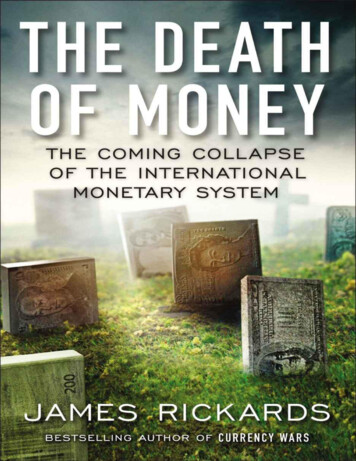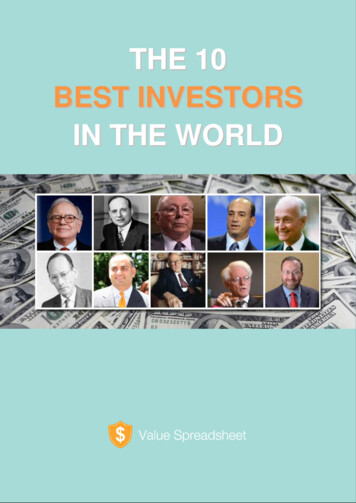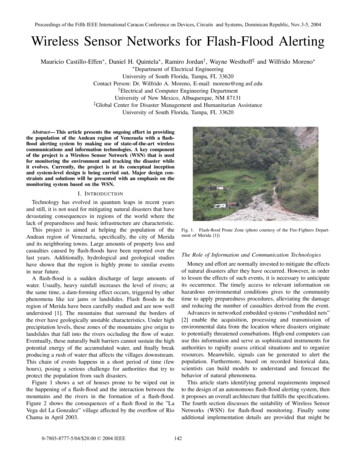
Transcription
THE DEATH OF MONEYTHE COMING COLLAPSEOF THE INTERNATIONALMONETARY SYSTEMJAMES RICKARDSPORTFOLIO / PENGUIN
PORTFOLIO / PENGUINPublished by the Penguin GroupPenguin Group (USA) LLC375 Hudson StreetNew York, New York 10014USA Canada UK Ireland Australia New Zealand India South Africa Chinapenguin.comA Penguin Random House CompanyFirst published by Portfolio / Penguin, a member of Penguin Group (USA) LLC, 2014Copyright 2014 by James RickardsPenguin supports copyright. Copyright fuels creativity, encourages diverse voices, promotes free speech, and creates a vibrant culture. Thank you for buying anauthorized edition of this book and for complying with copyright laws by not reproducing, scanning, or distributing any part of it in any form without permission.You are supporting writers and allowing Penguin to continue to publish books for every reader.ISBN 978-1-101-63724-1Designed by Alissa Rose TheodorVersion 1
For Glen, Wayne, Keith, Diane, and Eric—all best friends since the days we were born
Write down, therefore, what you have seen, and what is happening, and what will happen afterwards.Revelation 1:19
CONTENTSTITLE PAGECOPYRIGHTDEDICATIONEPIGRAPHINTRODUCTIONPART ONEMONEY AND GEOPOLITICSCHAPTER 1ProphesyCHAPTER 2The War God’s FacePART TWOMONEY AND MARKETSCHAPTER 3The Ruin of MarketsCHAPTER 4China’s New Financial WarlordsCHAPTER 5The New German ReichCHAPTER 6BELLs, BRICS, and BeyondPART THREEMONEY AND WEALTHCHAPTER 7Debt, Deficits, and the DollarCHAPTER 8Central Bank of the WorldCHAPTER 9Gold ReduxCHAPTER 10
CrossroadsCHAPTER SELECTED SOURCESINDEX
INTRODUCTIONThe Death of Money is about the demise of the dollar. By extension, it is also about the potentialcollapse of the international monetary system because, if confidence in the dollar is lost, no othercurrency stands ready to take its place as the world’s reserve currency. The dollar is the linchpin. If itfails, the entire system fails with it, since the dollar and the system are one and the same. As fearsomea prospect as this dual collapse may be, it looks increasingly inevitable for all the reasons one willfind in the pages to come.A journey to the past is in order first.Few Americans in our time recall that the dollar nearly ceased to function as the world’s reservecurrency in 1978. That year the Federal Reserve dollar index declined to a distressingly low level,and the U.S. Treasury was forced to issue government bonds denominated in Swiss francs. Foreigncreditors no longer trusted the U.S. dollar as a store of value. The dollar was losing purchasingpower, dropping by half from 1977 to 1981; U.S. inflation was over 50 percent during those fiveyears. Starting in 1979, the International Monetary Fund (IMF) had little choice but to mobilize itsresources to issue world money (special drawing rights, or SDRs). It flooded the market with 12.1billion SDRs to provide liquidity as global confidence in the dollar declined.We would do well to recall those dark days. The price of gold rose 500 percent from 1977 to1980. What began as a managed dollar devaluation in 1971, with President Richard Nixon’sabandonment of gold convertibility, became a full-scale rout by the decade’s end. The dollar debacleeven seeped into popular culture. The 1981 film Rollover, starring Jane Fonda, involved a secret planby oil-producing nations to dump dollars and buy gold; it ended with a banking collapse, a financialpanic, and global riots. That was fiction but indeed was powerful, perhaps prescient.While the dollar panic reached a crescendo in the late 1970s, lost confidence was felt as early asAugust 1971, immediately after President Nixon’s abandonment of the gold-backed dollar. AuthorJanet Tavakoli describes what it was like to be an American abroad the day the dollar’s death throesbecame glaringly apparent:Suddenly Americans traveling abroad found that restaurants, hotels, and merchants did not wantto take the floating rate risk of their dollars. On Ferragosto [mid-August holiday], banks inRome were closed, and Americans caught short of cash were in a bind.The manager of the hotel asked departing guests: “Do you have gold? Because look whatyour American President has done.” He was serious about gold; he would accept it aspayment. . . .I immediately asked to pre-pay my hotel bill in lire. . . . The manager clapped his hands indelight. He and the rest of the staff treated me as if I were royalty. I wasn’t like those otherAmericans with their stupid dollars. For the rest of my stay, no merchant or restaurant wantedmy business until I demonstrated I could pay in lire.
The subsequent efforts of Fed chairman Paul Volcker and the newly elected Ronald Reagan wouldsave the dollar. Volcker raised interest rates to 19 percent in 1981 to snuff out inflation and make thedollar an attractive choice for foreign capital. Beginning in 1981, Reagan cut taxes and regulation,which restored business confidence and made the United States a magnet for foreign investment. ByMarch 1985, the dollar index had rallied 50 percent from its October 1978 low, and gold prices haddropped 60 percent from their 1980 high. The U.S. inflation rate fell from 13.5 percent in 1980 to 1.9percent in 1986. The good news was such that Hollywood released no Rollover 2. By the mid-1980s,the fire was out, and the age of King Dollar had begun. The dollar had not disappeared as the world’sreserve currency after 1978, but it was a near run thing.Now the world is back to the future.A similar constellation of symptoms to those of 1978 can be seen in the world economy today. InJuly 2011 the Federal Reserve dollar index hit an all-time low, over 4 percent below the October1978 panic level. In August 2009 the IMF once again acted as a monetary first responder and rode tothe rescue with a new issuance of SDRs, equivalent to 310 billion, increasing the SDRs incirculation by 850 percent. In early September gold prices reached an all-time high, near 1,900 perounce, up more than 200 percent from the average price in 2006, just before the new depressionbegan. Twenty-first-century popular culture enjoyed its own version of Rollover, a televised tale offinancial collapse called Too Big to Fail.The parallels between 1978 and recent events are eerie but imperfect. There was an elementravaging the world then that is not apparent today. It is the dog that didn’t bark: inflation. But the factthat we aren’t hearing the dog doesn’t mean it poses no danger. Widely followed U.S. dollar inflationmeasures such as the consumer price index have barely budged since 2008; indeed, mild deflationhas emerged in certain months. Inflation has appeared in China, where the government revalued thecurrency to dampen it, and in Brazil, where price hikes in basic services such as bus fares triggeredriots. Food price inflation was also a contributing factor to protests in the Arab Spring’s early stages.Still, U.S. dollar inflation has remained subdued.Looking more closely, we see a veritable cottage industry that computes U.S. price indexes usingpre-1990 methodologies, and alternative baskets of goods and services that are said to be morerepresentative of the inflation actually facing Americans. They offer warning signs, as the alternativemethods identify U.S. inflation at more like 9 percent annually, instead of the 2 percent readings ofofficial government measures. Anyone shopping for milk, bread, or gasoline would certainly agreewith the higher figure. As telling as these shadow statistics may be, they have little impact oninternational currency markets or Federal Reserve policy. To understand the threats to the dollar, andpotential policy responses by the Federal Reserve, it is necessary to see the dollar through the Fed’seyes. From that perspective, inflation is not a threat; indeed, higher inflation is both the Fed’s answerto the debt crisis and a policy objective.This pro-inflation policy is an invitation to disaster, even as baffled Fed critics scratch their headsat the apparent absence of inflation in the face of unprecedented money printing by the FederalReserve and other major central banks. Many ponder how it is that the Fed has increased the basemoney supply 400 percent since 2008 with practically no inflation. But two explanations are verymuch at hand—and they foretell the potential for collapse. The first is that the U.S. economy isstructurally damaged, so the easy money cannot be put to good use. The second is that the inflation iscoming. Both explanations are true—the economy is broken, and inflation is on its way.
The Death of Money examines these events in a distinctive way. The chapters that follow lookcritically at standard economic tools such as equilibrium models, so-called value-at-risk metrics, andsupposed correlations. You will see that the general equilibrium models in widespread use aremeaningless in a state of perturbed equilibrium or dual equilibria. The world economy is not yet inthe “new normal.” Instead, the world is on a journey from old to new with no compass or chart.Turbulence is now the norm.Danger comes from within and without. We have a misplaced confidence that central banks cansave the day; in fact, they are ruining our markets. The value-at-risk models used by Wall Street andregulators to measure the dangers that derivatives pose are risible; they mask overleveraging, whichis shamelessly transformed into grotesque compensation that is throwing our society out of balance.When the hidden costs come home to roost and taxpayers are once again stuck with the bill, thebankers will be comfortably ensconced inside their mansions and aboard their yachts. The titans willexplain to credulous reporters and bought-off politicians that the new collapse was nothing they couldhave foreseen.While we refuse to face truths about debts and deficits, dozens of countries all over the globe areputting pressure on the dollar. We think the gold standard is a historical relic, but there’s acontemporary scramble for gold around the world, and it may signify a move to return to the goldstandard. We greatly underestimate the dangers from a cyberfinancial attack and the risks of afinancial world war.Regression analysis and correlations, so beloved by finance quants and economists, are ineffectivefor navigating the risks ahead. These analyses assume that the future resembles the past to an extent.History is a great teacher, but the quants’ suppositions contain fatal flaws. The first is that in lookingback, they do not look far enough. Most data used on Wall Street extend ten, twenty, or thirty yearsinto the past. The more diligent analysts will use hundred-year data series, finding suitable substitutesfor instruments that did not exist that far back. But the two greatest civilizational collapses in history,the Bronze Age collapse and the fall of the Roman Empire, occurred sixteen hundred years apart, andthe latter was sixteen hundred years ago. This is not to suggest civilization’s imminent collapse,merely to point out the severely limited perspective offered by most regressions. The other flawinvolves the quants’ failures to understand scaling dynamics that place certain risk measurementsoutside history. Since potential risk is an exponential function of system scale, and since the scale offinancial systems measured by derivatives is unprecedented, it follows that the risk too isunprecedented.While the word collapse as applied to the dollar sounds apocalyptic, it has an entirely pragmaticmeaning. Collapse is simply the loss of confidence by citizens and central banks in the futurepurchasing power of the dollar. The result is that holders dump dollars, either through faster spendingor through the purchase of hard assets. This rapid behavioral shift leads initially to higher interestrates, higher inflation, and the destruction of capital formation. The end result can be deflation(reminiscent of the 1930s) or inflation (reminiscent of the 1970s), or both.The coming collapse of the dollar and the international monetary system is entirely foreseeable.This is not a provocative conclusion. The international monetary system has collapsed three times inthe past century—in 1914, 1939, and 1971. Each collapse was followed by a tumultuous period. The1914 collapse was precipitated by the First World War and was followed later by alternatingepisodes of hyperinflation and depression from 1919 to 1922 before regaining stability in the mid-
1920s, albeit with a highly flawed gold standard that contributed to a new collapse in the 1930s. TheSecond World War caused the 1939 collapse, and stability was restored only with the Bretton Woodssystem, created in 1944. The 1971 collapse was precipitated by Nixon’s abandonment of goldconvertibility for the dollar, although this dénouement had been years in the making, and it wasfollowed by confusion, culminating in the near dollar collapse in 1978.The coming collapse, like those before, may involve war, gold, or chaos, or it could involve allthree. This book limns the most imminent threats to the dollar, likely to play out in the next few years,which are financial warfare, deflation, hyperinflation, and market collapse. Only nations andindividuals who make provision today will survive the maelstrom to come.In place of fallacious, if popular, methods, this book considers complexity theory to be the bestlens for viewing present risks and likely outcomes. Capital markets are complex systems nonpareil.Complexity theory is relatively new in the history of science, but in its sixty years it has beenextensively applied to weather, earthquakes, social networks, and other densely connected systems.The application of complexity theory to capital markets is still in its infancy, but it has alreadyyielded insights into risk metrics and price dynamics that possess greater predictive power thanconventional methods.As you will see in the pages that follow, the next financial collapse will resemble nothing inhistory. But a more clear-eyed view of opaque financial happenings in our world can help investorsthink through the best strategies. In this book’s conclusion you will find some recommendations, butdeciding upon the best course to follow will require comprehending a minefield of risks, whilepoised at a crossroads, pondering the death of the dollar.Beyond mere market outcomes, consider financial war. FinancialWarAre we prepared to fight a financial war? The conduct of financial war is distinct from normaleconomic competition among nations because it involves intentional malicious acts rather than solelycompetitive ones. Financial war entails the use of derivatives and the penetration of exchanges tocause havoc, incite panic, and ultimately disable an enemy’s economy. Financial war goes wellbeyond industrial espionage, which has existed at least since the early 1800s, when an American,Francis Cabot Lowell, memorized the design for the English power loom and recreated one in theUnited States.The modern financial war arsenal includes covert hedge funds and cyberattacks that cancompromise order-entry systems to mimic a flood of sell orders on stocks like Apple, Google, andIBM. Efficient-market theorists who are skeptical of such tactics fail to fathom the irrationalunderbelly of markets in full flight. Financial war is not about wealth maximization but victory.Risks of financial war in the age of dollar hegemony are novel because the United States has neverhad to coexist in a world where market participants did not depend on it for their national security.Even at the height of dollar flight in 1978, Germany, Japan, and the oil exporters were expected toprop up the dollar because they were utterly dependent on the United States to protect them against
Soviet threats. Today powerful nations such as Russia, China, and Iran do not rely on the UnitedStates for their national security, and they may even see some benefit in an economically woundedAmerica. Capital markets have moved decisively into the realm of strategic affairs, and Wall Streetanalysts and Washington policy makers, who most need to understand the implications, are only dimlyaware of this new world. InflationCritics from Richard Cantillon in the early eighteenth century to V. I. Lenin and John Maynard Keynesin the twentieth have been unanimous in their view that inflation is the stealth destroyer of savings,capital, and economic growth.Inflation often begins imperceptibly and gains a foothold before it is recognized. This lag incomprehension, important to central banks, is called money illusion, a phrase that refers to aperception that real wealth is being created, so that Keynesian “animal spirits” are aroused. Onlylater is it discovered that bankers and astute investors captured the wealth, and everyday citizens areleft with devalued savings, pensions, and life insurance.The 1960s and 1970s are a good case study in money illusion. From 1961 through 1965, annualU.S. inflation averaged 1.24 percent. In 1965 President Lyndon Johnson began a massive bout ofspending and incurred budget deficits with his “guns and butter” policy of an expanded war inVietnam and Great Society benefits. The Federal Reserve accommodated this spending, and thataccommodation continued through President Nixon’s 1972 reelection. Inflation was gradual at first; itclimbed to 2.9 percent in 1966 and 3.1 percent in 1967. Then it spun out of control, reaching 5.7percent in 1970, finally peaking at 13.5 percent in 1980. It was not until 1986 that inflation returned tothe 1.9 percent level more typical of the early 1960s.Two lessons from the 1960s and 1970s are highly pertinent today. The first is that inflation cangain substantial momentum before the general public notices it. It was not until 1974, nine years intoan inflationary cycle, that inflation became a potent political issue and prominent public policyconcern. This lag in momentum and perception is the essence of money illusion.Second, once inflation perceptions shift, they are extremely difficult to reset. In the Vietnam era, ittook nine years for everyday Americans to focus on inflation, and an additional eleven years toreanchor expectations. Rolling a rock down a hill is much faster than pushing it back up to the top.More recently, since 2008 the Federal Reserve has printed over 3 trillion of new money, butwithout stoking much inflation in the United States. Still, the Fed has set an inflation target of at least2.5 percent, possibly higher, and will not relent in printing money until that target is achieved. TheFed sees inflation as a way to dilute the real value of U.S. debt and avoid the specter of deflation.Therein lies a major risk. History and behavioral psychology both provide reason to believe thatonce the inflation goal is achieved and expectations are altered, a feedback loop will emerge inwhich higher inflation leads to higher inflation expectations, to even higher inflation, and so on. TheFed will not be able to arrest this feedback loop because its dynamic is a function not of monetarypolicy but of human nature.
As the inflation feedback loop gains energy, a repetition of the late 1970s will be in prospect.Skyrocketing gold prices and a crashing dollar, two sides of the same coin, will happen quickly. Thedifference between the next episode of runaway inflation and the last is that Russia, China, and theIMF will stand ready with gold and SDRs, not dollars, to provide new reserve assets. When thedollar next falls from the high wire, there will be no net. DeflationThere has been no episode of persistent deflation in the United States since the period from 1927 to1933; as a result, Americans have practically no living memory of deflation. The United States wouldhave experienced severe deflation from 2009 to 2013 but for massive money printing by the FederalReserve. The U.S. economy’s prevailing deflationary drift has not disappeared. It has only beenpapered over.Deflation is the Federal Reserve’s worst nightmare for many reasons. Real gains from deflationcannot easily be taxed. If a school administrator earns 100,000 per year, prices are constant, and shereceives a 5 percent raise, her real pretax standard of living has increased 5,000, but the governmenttaxes the increase, leaving less for the individual. But if her earnings are held constant, and pricesdrop 5 percent, she has the same 5,000 increase in her standard of living, but the government cannottax the gain because it comes in the form of lower prices rather than higher wages.Deflation increases the real value of government debt, making it harder to repay. If deflation is notreversed, there will be an outright default on the national debt, rather than the less traumatic outcomeof default-by-inflation. Deflation slows nominal GDP growth, while nominal debt rises every yeardue to budget deficits. This tends to increase the debt-to-GDP ratio, placing the United States on thesame path as Greece and making a sovereign debt crisis more likely.Deflation also increases the real value of private debt, creating a wave of defaults andbankruptcies. These losses then fall on the banks, causing a banking crisis. Since the primary mandateof the Federal Reserve is to prop up the banking system, deflation must be avoided because it inducesbad debts that threaten bank solvency.Finally, deflation feeds on itself and is nearly impossible for the Fed to reverse. The FederalReserve is confident about its ability to control inflation, although the lessons of the 1970s show thatextreme measures may be required. The Fed has no illusions about the difficulty of ending deflation.When cash becomes more valuable by the day, deflation’s defining feature, people and businesseshoard it and do not spend or invest. This hoarding crushes aggregate demand and causes GDP toplunge. This is why the Fed has printed over 3 trillion of new money since 2008—to bar deflationfrom starting in the first place. The most likely path of Federal Reserve policy in the years ahead isthe continuation of massive money printing to fend off deflation. The operative assumption at the Fedis that any inflationary consequences can be dealt with in due course.In continuing to print money to subdue deflation, the Fed may reach the political limits of printing,perhaps when its balance sheet passes 5 trillion, or when it is rendered insolvent on a mark-tomarket basis. At that point, the Fed governors may choose to take their chances with deflation. In this
dance-with-the-Devil scenario, the Fed would rely on fiscal policy to keep aggregate demand afloat.Or deflation may prevail despite money printing. This can occur when the Fed throws money fromhelicopters, but citizens leave it on the ground because picking it up entails debt. In either scenario,the United States would suddenly be back to 1930 facing outright deflation.In such a circumstance, the only way to break deflation is for the United States to declare byexecutive order that gold’s price is, say, 7,000 per ounce, possibly higher. The Federal Reservecould make this price stick by conducting open-market operations on behalf of the Treasury using thegold in Fort Knox. The Fed would be a gold buyer at 6,900 per ounce and a seller at 7,100 perounce in order to maintain a 7,000-per-ounce price. The purpose would not be to enrich goldholders but to reset general price levels.Such moves may seem unlikely, but they would be effective. Since nothing moves in isolation, thiskind of dollar devaluation against gold would quickly be reflected in higher dollar prices foreverything else. The world of 7,000 gold is also the world of 400-per-barrel oil and 100-perounce silver. Deflation’s back can be broken when the dollar is devalued against gold, as occurred in1933 when the United States revalued gold from 20.67 per ounce to 35.00 per ounce, a 41 percentdollar devaluation. If the United States faces severe deflation again, the antidote of dollar devaluationagainst gold will be the same, because there is no other solution when printing money fails. MarketCollapseThe prospect of a market collapse is a function of systemic risk independent of fundamental economicpolicy. The risk of market collapse is amplified by regulatory incompetence and banker greed.Complexity theory is the proper framework for analyzing this risk.The starting place in this analysis is the recognition that capital markets exhibit all four of complexsystems’ defining qualities: diversity of agents, connectedness, interdependence, and adaptivebehavior. Concluding that capital markets are complex systems has profound implications forregulation and risk management. The first implication is that the proper measurement of risk is thegross notional value of derivatives, not the net amount. The gross size of all bank derivativespositions now exceeds 650 trillion, more than nine times global GDP.A second implication is that the greatest catastrophe that can occur in a complex system is anexponential, nonlinear function of systemic scale. This means that as the system doubles or triples inscale, the risk of catastrophe is increasing by factors of 10 or 100. This is also why stress tests basedon historic episodes such as 9/11 or 2008 are of no value, since unprecedented systemic scalepresents unprecedented systemic risk.The solutions to this systemic risk overhang are surprisingly straightforward. The immediate taskswould be to break up large banks and ban most derivatives. Large banks are not necessary to globalfinance. When large financing is required, a lead bank can organize a syndicate, as was routinelydone in the past for massive infrastructure projects such as the Alaska pipeline, the original fleets ofsupertankers, and the first Boeing 747s. The benefit of breaking up banks would not be that bankfailures would be eliminated, but that bank failure would no longer be a threat. The costs of failure
would become containable and would not be permitted to metastasize so as to threaten the system.The case for banning most derivatives is even more straightforward. Derivatives serve practically nopurpose except to enrich bankers through opaque pricing and to deceive investors through off-thebalance-sheet accounting.Whatever the merits of these strategies, the prospects for dissolving large banks or banningderivatives are nil. This is because regulators use obsolete models or rely on the bankers’ ownmodels, leaving them unable to perceive systemic risk. Congress will not act because the members,by and large, are in thrall to bank political contributions.Banking and derivatives risk will continue to grow, and the next collapse will be of unprecedentedscope because the system scale is unprecedented. Since Federal Reserve resources were barely ableto prevent complete collapse in 2008, it should be expected that an even larger collapse willoverwhelm the Fed’s balance sheet. Since the Fed has printed over 3 trillion in a time of relativecalm, it will not be politically feasible to respond in the future by printing another 3 trillion. Thetask of reliquefying the world will fall to the IMF, because the IMF will have the only clean balancesheet left among official institutions. The IMF will rise to the occasion with a towering issuance ofSDRs, and this monetary operation will effectively end the dollar’s role as the leading reservecurrency. A Delugeof DangersThese threats to the dollar are ubiquitous. The endogenous threats are the Fed’s money printing andthe specter of galloping inflation. The exogenous threats include the accumulation of gold by Russiaand China (about which more in chapter 9) that presages a shift to a new reserve asset.There are numerous ancillary threats. If inflation does not emerge, it will be because ofunstoppable deflation, and the Fed’s response will be a radical reflation of gold. Russia and Chinaare hardly alone in their desire to break free from the dollar standard. Iran and India may lead a moveto an Asian reserve currency, and Gulf Cooperation Council members may chose to price oil exportsin a new regional currency issued by a central bank based in the Persian Gulf. Geopolitical threats tothe dollar may not be confined to economic competition but may turn malicious and take the form offinancial war. Finally, the global financial system may simply collapse on its own without a frontalassault due to its internal complexities and spillover effects.For now, the dollar and the international monetary system are synonymous. If the dollar collapses,the international monetary system will collapse as well; it cannot be otherwise. Everyday citizens,savers, and pensioners will be the main victims in the chaos that follows a collapse, although such acollapse does not mean the end of trade, finance, or banking. The major financial players, whetherthey be nations, banks, or multilateral institutions, will muddle through, while finance ministers,central bankers, and heads of state meet nonstop to patch together new rules of the game. If socialunrest emerges before financial elites restore the system, nations are prepared with militarizedpolice, armies, drones, surveillance, and executive orders to suppress discontent.The future international monetary system will not be based on dollars because China, Russia, oil-
producing countries, and other emerging nations will collectively insist on an end to U.S. monetaryhegemony and the creation of a new monetary standard. Whether the new monetary standard will bebased on gold, SDRs, or a network of regional reserve currencies remains to be seen. Still, thechoices are few, and close study of the leading possibilities can give investors an edge and areasonable prospect for preserving wealth in this new world.The system has spun out of control; the altered state of the economic world, with new players,shifting allegiances, political ineptitude, and technological cha
bankers will be comfortably ensconced inside their mansions and aboard their yachts. The titans will explain to credulous reporters and bought-off politicians that the new collapse was nothing they could have foreseen. While we refuse to face truths about debts and deficits, dozens of countries all over the globe are putting pressure on the dollar.










